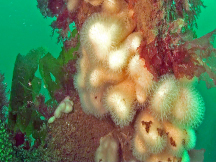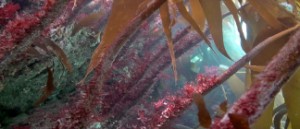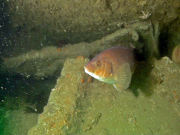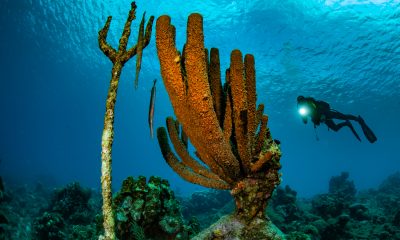Marine Life & Conservation Blogs
Jumping Sunfish
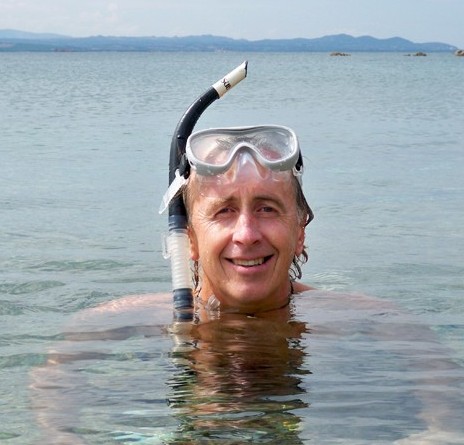
It’s been quite a few years since I have dived in the UK. I guess in many ways I have been spoilt with tropical destinations. I decided to leave my old drysuit in the cupboard and embrace this lovely summer with a wet suit. As it turned out, I almost regretted it but the dive was quite shallow and not too cold. I was diving with Mark Milburn from Atlantic Scuba near Falmouth who knows the coast here like the back of his hand and was taking us to the wreck of the Hera where I was giving an introductory session for my underwater video courses.
 We were gradually getting ready to go in the water when I saw out of the corner of my eye a good sized fish jumping out of the water. As I shouted, all four people on the boat looked around only to see the remains of a splash where the fish had disappeared. There was something odd about it. The shape was wrong and the splash slightly different from any fish I might have expected to see leap from the water. Then as we were talking about what it could have been, it jumped again. This time we all saw it and to my delight recognised it immediately as a very large Sun Fish (mola mola). It came fully out of the water and flopped back in on its side. I had no idea they did that. I have since looked up other possible instances on the web and Wikipedia tell me that yes they do this occasionally and recount a story of a young lad being knocked over in his boat while fishing with his family off the coast of Pembrokeshire, Wales. http://news.bbc.co.uk/1/hi/wales/4192566.stm The 30kg fish had leapt from the water and landed on top of him. Amazing. Wikipedia has a picture of 1600Kg sunfish caught off South Africa. We don’t see them that size any more – same old story of over fishing to near extinction. Its specific name, mola, is Latin for “millstone”, which the fish resembles because of its grey colour, rough texture, and rounded body. Its common English name, sunfish, refers to the animal’s habit of sunbathing at the surface of the water.
We were gradually getting ready to go in the water when I saw out of the corner of my eye a good sized fish jumping out of the water. As I shouted, all four people on the boat looked around only to see the remains of a splash where the fish had disappeared. There was something odd about it. The shape was wrong and the splash slightly different from any fish I might have expected to see leap from the water. Then as we were talking about what it could have been, it jumped again. This time we all saw it and to my delight recognised it immediately as a very large Sun Fish (mola mola). It came fully out of the water and flopped back in on its side. I had no idea they did that. I have since looked up other possible instances on the web and Wikipedia tell me that yes they do this occasionally and recount a story of a young lad being knocked over in his boat while fishing with his family off the coast of Pembrokeshire, Wales. http://news.bbc.co.uk/1/hi/wales/4192566.stm The 30kg fish had leapt from the water and landed on top of him. Amazing. Wikipedia has a picture of 1600Kg sunfish caught off South Africa. We don’t see them that size any more – same old story of over fishing to near extinction. Its specific name, mola, is Latin for “millstone”, which the fish resembles because of its grey colour, rough texture, and rounded body. Its common English name, sunfish, refers to the animal’s habit of sunbathing at the surface of the water.
 With the Sunfish now in the back of our minds we dived down to the wreck. Visibility wasn’t too great but as the wreck came into view I was greeted by a lovely array of bright Dead Mans Fingers with their delicate polyps gathering food in the slight current. I had forgotten just how spectacular they can be.
With the Sunfish now in the back of our minds we dived down to the wreck. Visibility wasn’t too great but as the wreck came into view I was greeted by a lovely array of bright Dead Mans Fingers with their delicate polyps gathering food in the slight current. I had forgotten just how spectacular they can be.
Moving on across the wreck site I saw a large wrasse disappear into the kelp and under a piece of wreck plating. I stuck my head in to look for it. A miniature forest of kelp stalks and fronds filtered the sun light and gave a feeling of a secret world, quiet and protected from the sea above. It was enchanting. Kelp is used for so many things in our society, from food proteins to cosmetics. It is used on the land for fertiliser and as a food in its own right. It is also and more importantly a stable ecosystem for many marine species.
A brief search revealed the wrasse taking refuge from me in the wreck’s man made cave. It was quite relaxed and I would have liked to spend more time with it but as my air was short I had to make my way back to the shot line for my 3 minute safety stop.
There is so much life here. Of course the water is cold and the visibility is often poor, but the diversity of life in our temperate waters is immense.
On the way back into Falmouth we noticed a small Dory type boat circling with the people in it pointing to something in the water. We headed over to see what was happening and saw a very small Basking Shark trying to head away. Seeing us, the people in the Dory obviously knew they were doing wrong by harassing the shark and so turned away and disappeared. Listed as endangered in the North East Atlantic Ocean, basking sharks are now protected by UK and international law. In the UK basking sharks are afforded full protection from intentional capture or disturbance in British waters (up to 12 miles offshore) under the 1998 Schedule 5 listing of the Wildlife and Countryside Act (1981). It makes sense really, so if you see these gentle sharks while out boating, please give them space. If they come to you then all well and good. It is a wonderful wildlife encounter when they do come near so please drive slowly and respectfully giving the shark plenty of room to avoid you if it feels threatened.
(Except for the Sun Fish, the photos in this article are taken from video frames on a Sony XR550.)
Marine Life & Conservation Blogs
Creature Feature: Undulate Ray

 In this series, the Shark Trust will be sharing amazing facts about different species of sharks and what you can do to help protect them.
In this series, the Shark Trust will be sharing amazing facts about different species of sharks and what you can do to help protect them.
This month we’re looking at the Undulate Ray. Easily identified by its beautiful, ornate pattern, the Undulate Ray gets its name from the undulating patterns of lines and spots on its dorsal side.
This skate is usually found on sandy or muddy sea floors, down to about 200 m deep, although it is more commonly found shallower. They can grow up to 90 cm total length. Depending on the size of the individual, their diet can range from shrimps to crabs.
Although sometimes called the Undulate Ray, this is actually a species of skate, meaning that, as all true skates do, they lay eggs. The eggs are contained in keratin eggcases – the same material that our hair and nails are made up of! These eggcases are also commonly called mermaid’s purses and can be found washed up on beaches all around the UK. If you find one, be sure to take a picture and upload your find to the Great Eggcase Hunt – the Shark Trust’s flagship citizen science project.
It is worth noting that on the south coasts, these eggcases can be confused with those of the Spotted Ray, especially as they look very similar and the ranges overlap, so we sometimes informally refer to them as ‘Spundulates’.
Scientific Name: Raja undulata
Family: Rajidae
Maximum Size: 90cm (total length)
Diet: shrimps and crabs
Distribution: found around the eastern Atlantic and in the Mediterranean Sea.
Habitat: shelf waters down to 200m deep.
Conservation Status : As a commercially exploited species, the Undulate Ray is a recovering species in some areas. The good thing is that they have some of the most comprehensive management measures of almost any elasmobranch species, with both minimum and maximum landing sizes as well as a closed season. Additionally, targeting is entirely prohibited in some areas. They are also often caught as bycatch in various fisheries – in some areas they can be landed whilst in others they must be discarded.
IUCN Red List Status: Endangered
For more great shark information and conservation visit the Shark Trust Website
Image Credits: Banner – Sheila Openshaw; Illustration – Marc Dando
Blogs
Guarding Against Coral Invaders
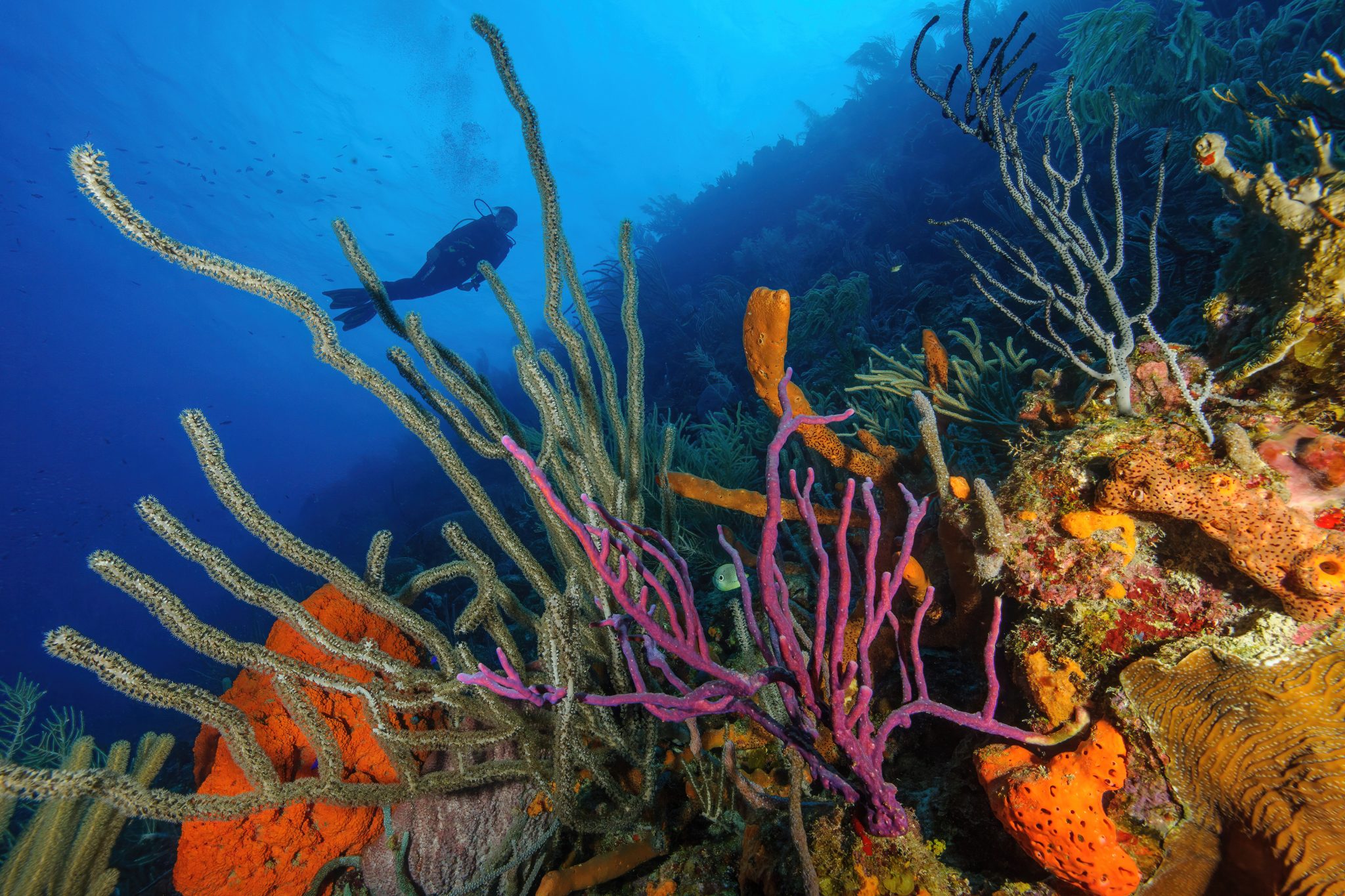
Protecting (Dutch) Caribbean Reefs from Unomia stolonifera
Recent reports highlight the concerning spread of the invasive soft coral, Unomia stolonifera, currently devastating Venezuela’s marine ecosystems and detected in Cuba. With the potential threat of its expansion to the (Dutch) Caribbean islands, urgent action and awareness are essential to safeguard marine biodiversity and local economies from possible catastrophic consequences.
Invasive species are animals or plants from another region of the world that don’t belong in their new environment. These species can have major ecological effects by decimating native flora or fauna. They can also cause large economic losses and impact human health. Invasive species also pose a significant threat to marine ecosystems worldwide, including the Dutch Caribbean. Among these invaders is the octocoral species Unomia stolonifera or “Pulsing Xenia”, originally from the Indo-Pacific. With its rapid growth and lack of natural predators, this species can outcompete native species and disrupt fragile marine habitats such as seagrass beds and coral reefs.
Background
The invasive soft coral U. stolonifera was first identified in 2014, off the coast of Venezuela. It is believed to have been introduced via the illegal aquarium trade. Since this species can reproduce sexually and asexually (or fragment), even small pieces can regenerate to spread. Once introduced it quickly took over shallow reefs and hard substrate at depths of 0-50 meters, outcompeting local corals and seagrass for space. Follow on surveys found that this coral species exhibited average percentage cover as high as 80%, vastly outcompeting native corals. In highly colonized areas, fish are disappearing due to loss of habitats.
In 2022, during a survey conducted in Cuba by the University of Havana, an unknown octocoral was discovered which was later identified as the invasive Unomia stolonifera. It is suspected that the coral larvae arrived in ballast water from fossil fuel ships originating from Venezuela, as nearby sites adjacent to Venezuelan ports have been heavily affected by the invasion.
How to help
Prevention through continuous monitoring, particularly in high-risk areas such as marine harbors and oil facilities, is paramount. Early detection plays a pivotal role in mitigating the threat posed by Unomia stolonifera.
The public’s involvement and awareness are also vital. Local communities, recreational divers, tourists, and all stakeholders are urged to participate in early detection efforts by reporting sightings (photo, location and date) of this invasive coral to their respective Protected Area Management Organization (PMO’s)- the Fundacion Parke Nacional Aruba (FPNA), STINAPA Bonaire, CARMABI Curaçao , Saba Conservation Foundation (SCF), Nature Foundation St. Maarten (NFSXM) and St. Eustatius National Parks (STENAPA). If an invaded area is confirmed, follow the recommendations by the local PMO’s.
Keys to Success
Despite the challenges, early detection is key to mitigating the threat posed by Unomia stolonifera. With continued vigilance, research, and community engagement, there is hope for containing this potential issue before it becomes a major threat.
About the DCNA
The Dutch Caribbean Nature Alliance (DCNA) supports (science) communication and outreach in the Dutch Caribbean region by making nature related (scientific) information more widely available through amongst others the Dutch Caribbean Biodiversity Database, DCNA’s news platform BioNews and through the press. This article contains the results from several scientific studies but the studies themselves are not DCNA studies. No rights can be derived from the content. DCNA is not liable for the content and the in(direct) impacts resulting from publishing this article.
-

 News3 months ago
News3 months agoHone your underwater photography skills with Alphamarine Photography at Red Sea Diving Safari in March
-

 News2 months ago
News2 months agoCapturing Critters in Lembeh Underwater Photography Workshop 2024: Event Roundup
-

 Marine Life & Conservation Blogs2 months ago
Marine Life & Conservation Blogs2 months agoCreature Feature: Swell Sharks
-

 Blogs1 month ago
Blogs1 month agoMurex Resorts: Passport to Paradise!
-
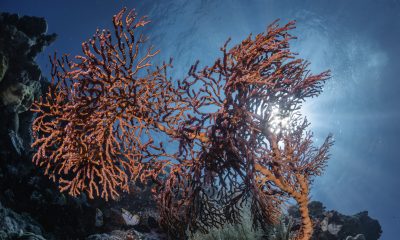
 News3 months ago
News3 months agoDive into Adventure with Photo Pro Paul Duxfield in North Sulawesi this October
-

 Gear News3 months ago
Gear News3 months agoBare X-Mission Drysuit: Ideal for Both Technical and Recreational Divers
-

 Gear Reviews2 months ago
Gear Reviews2 months agoGear Review: Oceanic+ Dive Housing for iPhone
-

 Blogs2 months ago
Blogs2 months agoDiver Discovering Whale Skeletons Beneath Ice Judged World’s Best Underwater Photograph


